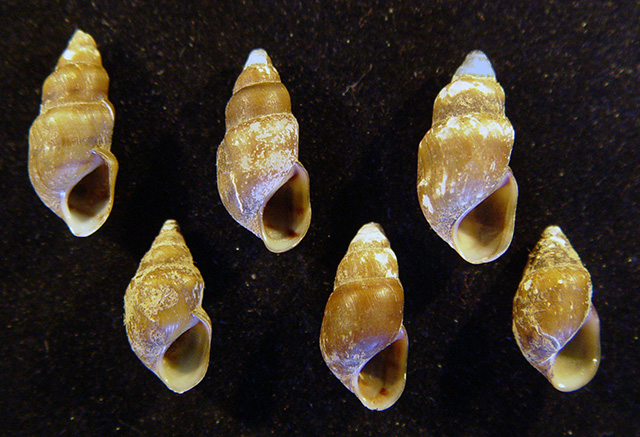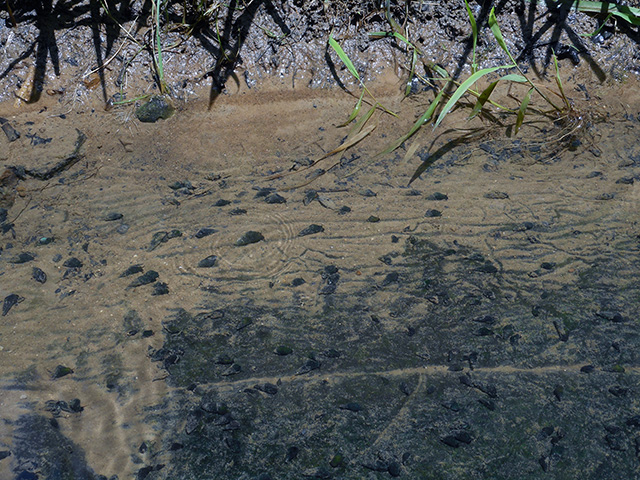Goniobasis or Elimia semicarinata
> Habitat & Distribution
The range of P. semicarinata (in its typical shell form) was given by Goodrich (1940) as "tributaries of Ohio River, Scioto River, Ohio, to Big Blue River, Indiana; Licking River to Salt River in Kentucky; two creeks of Green River of Kentucky." Our modern surveys have confirmed that range and expanded it south through most of the Cumberland River drainage of Middle Tennessee, including the Obey, Caney/Collins, and East Fork Stones River systems. Through that range populations of P. semicarinata semicarinata primarily inhabit creeks and rivers (up to moderate size) with hard water, substantial flow, and rocky substrate.
Populations inhabiting more northern latitudes tend to bear shells with a lower spire, and are here referred to the subspecies P. semicarinata livescens (Menke, 1830). Those inhabiting large rivers tend to be more robustly-shelled, and are here referred to the subspecies P. semicarinata obovata (Say, 1829). The FWGNA incidence rank calculated for all three subspecies together, across a range extending from Vermont to Wisconsin and Tennessee into Ontario, is I-5.
> Ecology & Life History
Mancini (1978) reported egglaying from March to July in the population of P. semicarinata he studied in southern Indiana, each female laying a (remarkably small) average total of just 43 eggs per season, each egg of a remakably small size. Maturation seems to require 18 months, females apparently mating in their second fall and laying their first eggs two years after their own birth. Reproduction is annual and iteroparous thereafter, with a life span Mancini estimated to be 3 - 5 years. This is life cycle Hi of Dillon (2000: 156 - 162), typical for pleurocerids. The sex ratio in the field, sampled biweekly throughout the year, was 61 female:39 male.
The morphological and life history studies of Dazo (1965), although focused on populations bearing the shell form livescens in Michigan, returned results very similar to those of Mancini in Indiana. Dazo reported that mating takes place in the fall and egglaying April to August in Michigan, with eggs laid singly, in short rows, approximately 4/day. Eggs hatch in two weeks, with laboratory growth to approximately 3.8 mm in year one and to 7 mm in year two, at which time maturity is gained. Dazo estimated a "normal life span" of 3 - 4 years for adults in his Michigan populations of P. semicarinata livescens, with annual iteroparous reproduction. His laboratory-reared estimate of sex ratio was approximately 5 female:1 male.
Although neither of the studies of Mancini nor of Dazo contained sufficient bioenergetic data to estimate the weight relationship between parent and total annual reproductive output, Dillon's (2000: 126 - 135) reanalysis of the bioenergetic data published by Payne (1979) showed that New York populations of the livescens form demonstrate an order of magnitude lower reproductive effort than might be predicted from their mean adult body weight. This suggests that they are S-adapted, tolerant of a poor habitat that is nevertheless permanent and predictable.
Grazing by populations of pleurocerids can have a significant effect on energy flow in small streams (Dillon 2000: 86 - 91, see also Dillon & Davis 1991). Dazo reported that his Michigan populations of P. semicarinata livescens fed on "red and green algae, desmids and diatoms." He also reported significant rates of trematode parasitism, with azygiids, allocreads, and aspidogastrids "heavily parasitizing the liver, gonad, alimentary tract and other organs."
> Taxonomy & Systematics
As is typical for most North American pleurocerids, variability in the shell morphology of P. semicarinata has led to a great number of synonyms (eg, Bickel 1968). Dunithan and colleagues (2012) reported a gradual transition in the shell form of Pleurocera populations inhabiting the streams of Indiana, from those identified as semicarinata in the south (Goodrich & van der Schalie 1944) to those identified as livescens in the north. A similar transition can be observed elsewhere throughout the Midwest, correlated roughly with the glacial maximum. Dunithan and colleagues suggested that this phenomenon might be an ecophenotypic response to current or substrate, the more lotic southern environments yielding the typical semicarinata phenotype, the more lentic northern environments the livescens phenotype.
More recently Cazenave and Zanatta (2016) reported a correlation between the shape of shells borne by populations of Pleurocera semicarinata livescens on the shoreline of Lake Michigan and smaller inland lakes; the snails inhabiting higher-energy environments tending to bear more globose shells. The authors suggested that the larger-apertured, more globose morphology might be a response to the increased likelihood of dislodgement in exposed environments due to wave action.
Dillon's (2014) survey of gene frequencies at 11 allozyme-encoding loci confirmed the speculation of Dunithan and colleagues, extending the results to populations bearing an extremely robust shell phenotype previously identified as "Lithasia obovata," lowering both livescens and obovata to subspecific status under semicarinata. Goodrich (1934) also documented a variety of striking shell phenotypes in populations of (what he termed) Lithasia obovata (figure below). These are all varieties of Pleurocera semicarinata. More information about this surprising discovery is available from my essay of 11July14, link below.Hybridization between P. semicarinata (the livescens form) and a Hudson River population of P. virginica through the Erie Canal has been reported by Bianchi et al (1994). Such a remarkable phenomenon, generalized across a variety of species and regions, suggests reticulate evolution in the North American Pleuroceidae. See my essay of 12Nov24 from the link below for more.
This species has travelled through three genera in thirty years. Although predominantly assigned to Goniobasis through most of the 20th century, in the 1980s many workers began placing it in the resurrected generic nomen, "Elimia." Both Goniobasis and Elimia were subsumed under Pleurocera by Dillon (2011). See my essay of 23Mar11 from the link below for more.
> Maps and Supplementary Resources
- Distribution of the three subspecies in the drainage of The Ohio (2019)
- Distribution in the Tennessee/Cumberland (2022)
- Pleurocera semicarinata semicarinata from West Fork Drakes Creek in Simpson County, Kentucky, demonstrating a range of chunky and shouldered shell morphology. Goodrich (1934) called Pleurocera bearing shells of these forms "Lithasia obovata undosa," consanguinea, sordida, and so forth. Largest shell is 20.3 mm sl, remainder to scale.

- Pleurocera semicarinata in Harrison Creek, Kentucky.
 Click for high-resolution image.
Click for high-resolution image.
- Photomontage comparing male and female P. semicarinata, highlighting the egglaying groove (white arrow). Courtesy of T. Travis Brown.

> Essays
- Taxonomic controversy has surrounded the generic nomina Pleurocera, Goniobasis, and Elimia for many years. The best entry into the subject would be my essay of 23Mar11, entitled Goodbye Goniobasis, Farewell Elimia. Links are available from that essay to older resources.
- The concept of the subspecies, as that term is applied in the FWGNA Project, was elaborated in a pair of companion essays I posted in early 2014, "What is a Subspecies?" and "What Subspecies Are Not."
- On 11July14 I posted an essay elaborating the results of my (2014) paper on cryptic phenotypic plasticity in P. semicarinata, entitled "Elimia livescens and Lithasia obovata are Pleurocera semicarinata." That essay also includes a couple additional figures of extreme shell morphologies.
- I reviewed the longstanding confusion between Pleurocera semicarinata and Pleurocera shenandoa n.sp. in my blog post of 11March19.
- In my essay of 12Nov24 I reviewed what is known about hybridization between P. semicarinata and P. virginica through the Erie Canal, and speculated about hybridization between P. semicarinata and P. simplex as well. Such results, carried through the diverse pleurocerid fauna of the interior drainages, suggest Reticulate evolution in the North American Pleuroceridae.
- The conspecific relationship between populations of P. semicarinata bearing shells of the typical form and heavily-shelled populations of the subspecies obovata was confirmed by the phylogenomic study of Whelan et al (2022). See my essay of 23Sept25, Anchored hybrid enrichment, Pleurocerid evolution, and the obovata confirmation.
> References
Bianchi, T. S., G. M. Davis, and D. Strayer 1994. An apparent hybrid zone between freshwater gastropod species Elimia livescens and E. virginica (Gastropoda: Pleuroceridae). Am. Malac. Bull. 11: 73 - 78.
Bickel, D. (1968) Goniobasis semicarinata and G. indianensis in Blue River, Indiana. The Nautilus 81: 133 - 138.
Cazenave, K.R. & D. T. Zanatta (2016) Environmental drivers of shell shape in a freshwater gastropod from small and large lakes. Freshwater Science 35: 948-957.
Dazo, B. C. (1965) The morphology and natural history of Pleurocera acuta and Goniobasis livescens (Gastropoda: Cerithiacea: Pleuroceridae). Malacologia 3: 1 - 80.
Dillon, R. T. Jr. (2000) The Ecology of Freshwater Molluscs. Cambridge, Cambridge University Press. 509 pp.
Dillon, R. T. Jr. (2011) Robust shell phenotype is a local response to stream size in the genus Pleurocera (Rafinesque, 1818). Malacologia 53: 265-277. [pdf]
Dillon, R. T. Jr. (2014) Cryptic phenotypic plasticity in populations of the North American freshwater gastropod, Pleurocera semicarinata. Zool. Stud. 53:31. [pdf]
Dillon, R. T. Jr., & K. B. Davis (1991) The diatoms ingested by freshwater snails: temporal, spatial, and interspecific variation. Hydrobiologia 210: 233-242. [pdf]
Dunithan, A., S. Jacquemin & M. Pyron (2012) Morphology of Elimia livescens (Mollusca: Pleuroceridae) in Indiana, USA, covaries with environmental variation. Am. Malac. Bull. 30: 127 - 133.
Goodrich, C. (1934) Studies of the gastropod family Pleuroceridae I. Occas. Pprs. Mus. Zool. Univ. Mich. 286:1 - 17.
Goodrich, C. (1940) The Pleuroceridae of the Ohio River drainage system. Occas. Pprs. Mus. Zool. Univ. Mich., 417: 1-21.
Goodrich, C. & H. van der Schalie (1944) A revision of the Mollusca of Indiana. Am. Midl. Natur. 32: 257 - 326.
Jokinen, E.H. (1992) The Freshwater Snails (Mollusca: Gastropoda) of New York State. NY State Mus Bull 482, Albany, New York.
Mancini, E. R. (1978) The biology of Goniobasis semicarinata (Say) [Gastropoda: Pleuroceridae] in the Mosquito Creek drainage system, Southern Indiana. Ph.D. Dissertation, University of Louisville. 93 pp.
Payne, B. (1979) Bioenergetic budgeting of carbon and nitrogen in the life histories of three lake populations of the prosobranch snail Goniobasis livescens. PhD dissertation, Syracuse University.
Smith, D.G. (1980) Goniobasis virginica Gastropoda Pleuroceridae in the Connecticut River USA. Nautilus 94:50-54.
Whelan, N.V, P.D. Johnson, J.T. Garner, N. Garrison & E. Strong (2022) Prodigious polyphyly in Pleuroceridae (Gastropoda: Cerithioidea). Bulletin of the Society of Systematic Biologists 1(2). https;//doi.org/10.18061/bssb.viis.8419








